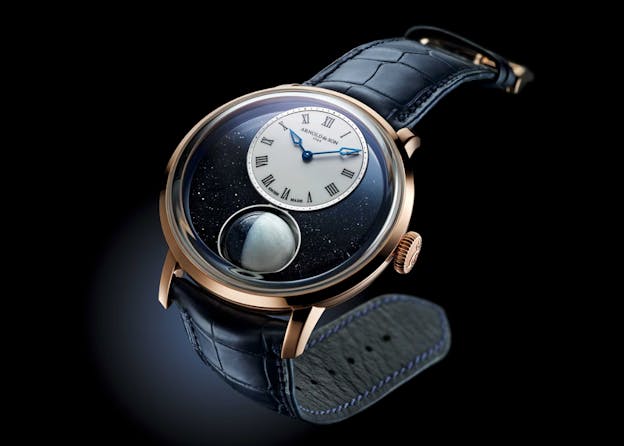The Many Forms of the Moon Phase Complication
Moon complications can be poetic, technical, or both. The Moon itself may never change, but it hasn’t stopped captivating watchmakers—and they’re still managing to find new ways of presenting it.
The moon phase is a complication that offers more creative possibilities than a tourbillon or chronograph. Van Cleef & Arpels would say it’s ‘poetic.’ Watchmakers can choose the Moon’s size, material, and display. Some might place it amid a starry sky, make it 3-D, or give it a non-circular window. It can be placed almost anywhere on the dial or even on the back of the watch. Of the many design possibilities, which route have watchmakers explored?
Changes in Practice
The moon phase complication broke free from several restraints over time. Not long ago, men were deemed fast and precise, lovers of thrills and technical details, so the chronograph and tourbillon were designed with them in mind. The likes of moon phases, mother-of-pearl, and diamonds were destined for women who were considered more attuned to nature, preferring aesthetic beauty to technical prowess.
Moons Small and Large

Fortunately, gender-specific complications and materials are primarily a thing of the past. Today, you can find the moon phase on all sorts of wrists in various forms. Some of these are singular and exotic, often the work of independent firms; Arnold & Son is a case in point. The La Chaux-de-Fonds-based firm has always gone for a fairly exuberant, oversized form of the moon phase. Its ‘Perpetual Moon’ takes up a good third of the dial, making it the star of the show and relegating the hours and minutes to mere supporting roles.
Another dimension of time opens up, inviting the owner to a pace of life in step with the Moon as it moves almost imperceptibly across a starry sky, month after month. Rather than hours—still less, minutes—day and night become the units of time. This rare, philosophical realm of watchmaking invites the wearer into another sort of time that Arnold & Son made a specialty.
3-D Moon
As a counterpoint to its Perpetual Moon, there’s the Luna Magna. The difference consists of nothing less than an additional dimension. Whereas the Perpetual Moon rises in two dimensions, the Luna Magna offers a genuinely three-dimensional sphere found at 6 o’clock. The dark and illuminated sides, made from marble and aventurine, appear with amazing accuracy—a correction is required only once every 122 years.

De Bethune
The lunar vision of three dimensions, two materials, and rare accuracy is one Arnold & Son shares with De Bethune. The latter brand, also fully independent, has always deemed the moon phase to be a complication that’s every bit as technical as it is aesthetic. The DB25, DB26 and DB28 all bear witness to this stance. The DB28 offers a highly contemporary, avant-garde interpretation of the moon phase. It’s located at 6 o’clock and combines palladium and flame-blued steel—a perfect illustration of the unique blend of modernity and tradition much beloved by De Bethune.

An Ode to Sobriety
Does H. Moser & Cie. fit in the same category? Yes and no. Like Arnold & Son and De Bethune, it’s a fully-independent Fine Watchmaking firm. However, the Endeavour Perpetual Moon takes an ultra-minimalist approach to the moon phase, almost completely integrated and concealed within an aventurine or Vantablack dial. This pared-down take on the complication is a thoroughly ‘Moser’ one.

Serving Tradition
Rolex, Patek Philippe, and Audemars Piguet, the three big players in the industry, take a more traditional approach to the moon phase. Rolex sees it as another product rather than a specialty: the Cellini Moonphase is not Rolex’s best-known timepiece, making it even more of a rarity, appreciated by collectors who like to forage off the beaten path.

The full moon, placed on a blue enamel disc at 6 o’clock, is depicted by a meteorite applique and the new moon by a circle. Each pass beneath an indicator at 12 o’clock, denoting the moon phase throughout a cycle.

Audemars Piguet and Patek Philippe stand out from the crowd, not necessarily because of their moon phase display or technical details but because the complication is available only with a perpetual calendar. You can only find the moon phase on Audemars Piguet’s Royal Oak (apart from one exception, the Royal Oak Offshore) and in Patek Philippe’s ‘Grandes Complications’ series.

Almost invariably, the Moon sits at 6 o’clock, opening in a dedicated window on a starry background, featuring a miniature depiction of its craters and shadows. The realistic result adds a poetic dimension to the highly technical QP timepiece.
The Outsider: Louis Moinet
What better way to keep in phase with the Moon than having a piece of it on your wrist? Louis Moinet’s soberly named Moon includes a real part of the Moon within its dial. Similar to Audemars Piguet and Patek Philippe moon phases, the attraction isn’t necessarily the complication but rather the entire timepiece.



